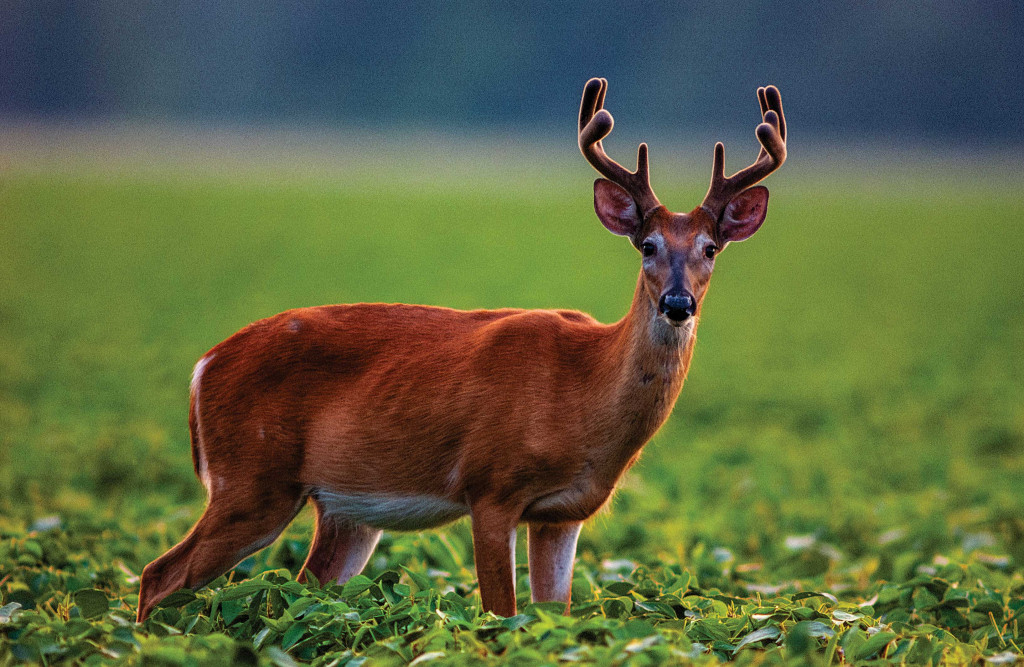
By Brian Peterson
In 2014, at the request of hunters, the Nebraska Game and Parks Commission opened archery season Sept. 1 so hunters could have an additional opportunity to harvest a velvet-antlered buck. Nebraska is one of a handful of states that offer an archery season early enough to provide this opportunity, but what is the likelihood there will still be velvet bucks in Nebraska when the season opens? And what biological factors are at play that hunters should know about?
Growing Antlers
Growing antlers is a complicated process that involves a number of factors, as well as pitfalls, for bucks. The growing process lasts about six months. Deer antlers are one of the fastest-growing living tissues on Earth, typically reaching one-quarter inch per day for white-tailed deer, and more in larger deer species, such as elk and moose. However, growing antlers is energetically costly and causes bucks to enter a state of temporary osteoporosis as they demineralize skeletal bones, primarily from their ribs, to acquire large amounts of essential minerals, such as calcium and phosphorus, to feed antler growth.
Antler development is a highly metabolic process during the velvet stage. Velvet covers and protects the tissues that contain blood vessels and nerves as the bone forms. It is sensitive to touch, and bucks will learn to avoid physical rubbing or contacting trees and other obstacles in their environment. An injury to the antlers during the velvet stage can affect the growth, final size and shape of antlers.
Newly-grown antlers remain covered in velvet until testosterone levels are high enough to cause blood flow to stop. As blood flow ceases, the velvet covering begins to dry, crack and peel away from the fully formed, hardened antler bone.
Triggered by shorter days that come as fall approaches, the shedding of velvet occurs during a short window from late August into September. Bucks accelerate shedding by rubbing and thrashing antlers on trees, bushes and other vegetation. The process can take anywhere from a few hours to several days. Bucks then carry their hard, calcified antlers for the remaining six months of the antler cycle.
Fuzzy to Calcified
Recently, researchers at the University of Nebraska at Kearney, including undergraduate Bodin Wilson, graduate Logan Dietrich and me, conducted a study to determine the time frame in which white-tailed deer in Nebraska shed their velvet, and compared velvet shedding between younger and older bucks. Our focus area included the South Loup and Platte rivers in central Nebraska.
We strategically placed 33 trail cameras in areas with high deer density from July through October 2022. We found no detectable differences between river drainages. White-tailed bucks shed velvet during a 35-day window, with the earliest observations of complete velvet shedding occurring by Aug. 22 and the latest date deer were seen retaining velvet Sept. 25. By Sept. 1, the beginning of Nebraska’s archery season, more than 12 percent of bucks had already shed their velvet. By Sept. 15, 67 percent of bucks had shed their velvet and by Sept. 20, 90 percent had done so. On average, we observed older deer completely shed velvet 13 percent, or three to four days, sooner than younger bucks.
Even with our intensive efforts, we only observed a few individuals in the process of velvet shedding, indicating this process occurs during a short time frame for individuals. Our study represents a snapshot of bucks during a single season.
Best Opportunities
Based on our findings in Nebraska, the best opportunity to harvest a mature, velvet-antlered white-tailed deer is during the first seven days of the archery season, with around 50 percent of males still retaining velvet. By mid-September, just 20 percent of the more sought-after mature bucks still retained velvet.
From my experience, bucks tend to be easier to pattern during early September. So, if you want a chance to harvest a velvet-antlered deer, you had better grab your license and bow or crossbow, play the wind, endure the heat, ticks and mosquitoes, and give it your best effort early in the season.
Brian Peterson is a biologist at the University of Nebraska at Kearney and coordinates the M.S. Biology Online Program. His research focus is white-tailed deer antler metrics. For more information, please contact petersonbc@unk.edu. He would like to thank the many landowners for allowing access to their properties, and Bodin Wilson and Logan Dietrich for their contributions to the research findings.
